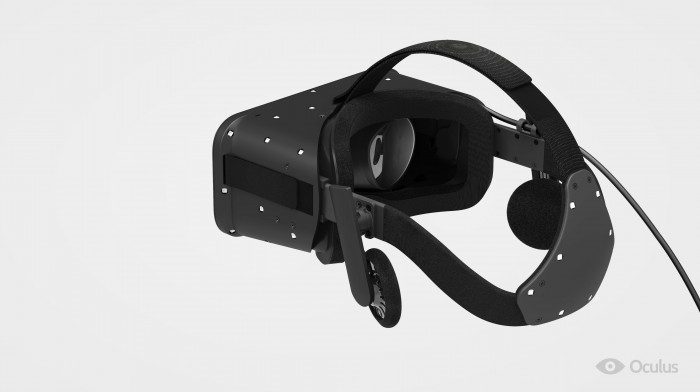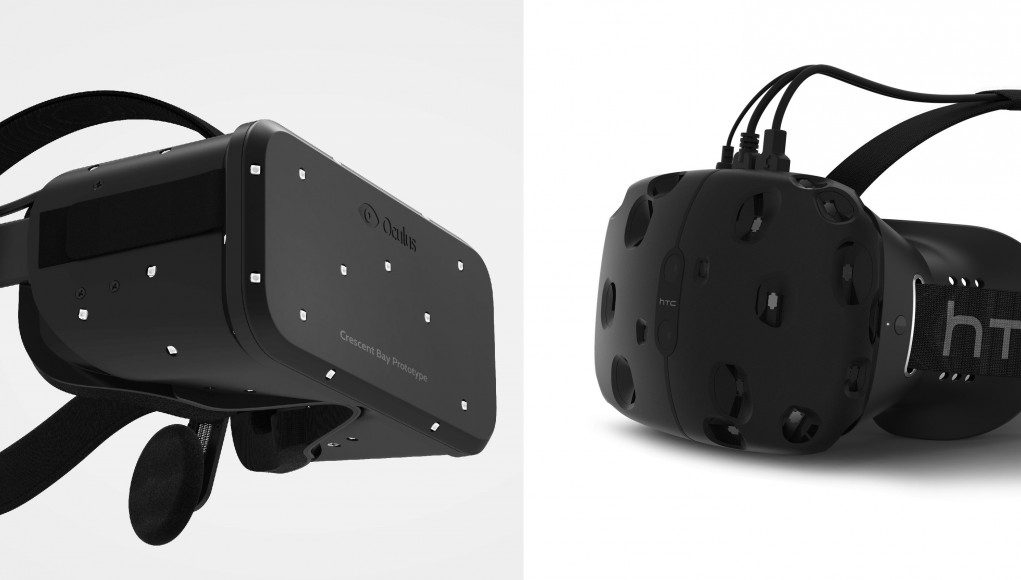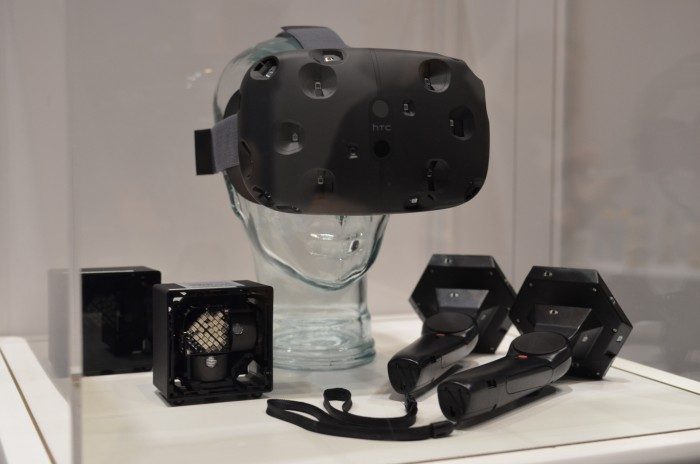After months of hearing about Oculus’ latest prototype VR headset, Crescent Bay, and pining after a session with the bleeding edge device for so long, I finally secured a demo with the Crescent Bay prototype at this year’s GDC. What I wasn’t counting on though, was that 24 hours later I would be thrown straight into the new HTC Vive.
I knew that I would be getting into the Unreal Engine 4 booth at this year’s GDC to try out a few demos with Crescent Bay for the first time. After months of watching video reviews, reading countless ‘hands-on’ articles, and asking just about every fellow VR enthusiast about the device, I was finally getting a chance to put my preparation to the test. Now it was my turn to jump up and down, and get low to the ground to see just how immersive my first stand-up VR experience could really be.

I was ushered into a small room at the UE4 booth hosting the much sought after demo, Thief in the Shadows, an experience built by the digital visual effects company founded by Peter Jackson, Weta Digital, that puts you into the treasure-strewn halls of Erebor, otherwise known as the lair of the dread villain Smaug of Tolkien lore. It was everything a LOTR fan could ask for.
See Also: First Hands-on: Oculus Rift Crescent Bay is Incredible
“Wow, you’re really testing it out,” my wrangler’s muffled voice protruded through my headphones as I got on all fours to get a close up view of the treasure. “Oh, don’t get too close to the table,” his voice trailed off as I bent down further to get a closer look at one of the millions of gold coins atop the pile—and that’s when positional tracking gave out for a few seconds, breaking the otherwise convincing illusion that I was in the same room as the boomingly posh accent of Smaug. The familiar sensation happened to me a million times at home back with my DK2, where suddenly the world is stopped in its tracks and you’re left shaking your head to relocate the invisible cone-shaped area that only the positional IR camera can see.
It was surprising, beautiful, but not nearly as perfect of a moment that I had imagined. I was immersed until I wasn’t, in some middle juncture that felt neither real, nor entirely fake. You can chalk it up to intrusive handlers, my insistence on rolling on the floor like a moron, but ultimately the culprit was me and my months of research that hyped my expectations of the prototype device. In short, Crescent Bay feels like a really, really good DK2 and although I’m humbled and grateful to be alive for the beginning of the VR revolution, I should have known better than to walk into a situation so indoctrinated.
Vive? – ReVive? – Veev? (certainly never ‘Re-Veev’)
I was asked to wait in Valve’s cordoned off ‘Steam Ballroom’, an area just off the expo floor dedicated almost entirely to the small demo rooms of the device, save a mini-museum of prototype units that acted as an informal mingle space for Valve employees to chat up the press. This time I had intentionally deprived myself of anything but the specs of the device—no hype-ups, freak-outs or the sort of long-winded article du jour that I love to both read and write—nothing but the facts sheet.
A few handshakes and ‘hello’s later and I was in a smallish room, likely the exact dimensions of the device’s suggested operating range, 15×15 feet. I was welcomed in and told that I would be taking part in a shortened demo, only a single 5-minute-long experience out of the handful of demos that made up the normal run-time of 30 minutes. Executive Editor Ben Lang got into that one twice. Twice. I’m not bitter about it because I spit in his coffee several times during the conference.
I looked up to see a tall bookshelf holding a number of familiar items; vases, books, decorative art, and on the top shelf was a little black box with a pair of offset laser beams rapidly blinking away—Valve’s Lighthouse positional solution that orients the headset along with the two hand controllers in 3D space.
See Also: 10 Things You Didn’t Know About Steam VR’s Lighthouse Tracking System
The handler said I would be getting ‘The Encounter,’ an underwater experience that puts you on the deck of a sunken ship. I was strapped into the device like any other VR headset, except for the mass of power/HDMI/USB cables and waist strap to offload some of the additional weight from my head. I strapped on the dimpled headset and so my first short-lived experience with Vive began.
I appeared in a white ‘menu room’ with a horizontal roll of demos, all of which were thoroughly tested by Ben, our Executive Editor. Thoroughly (not bitter, spit). Out of my peripheral vision I saw a motion controller float into view, and reached out curiously to the device, unsure if I would have to make any compensation for distance to grab it. It was exactly where my tried and true spatial sensibilities knew it would be, and was nothing short of satisfying to feel something, anything in a virtual space, even if it was just a rendered version of the strangely shaped device. This for me was the key point of separation, not the differing resolutions or fields of view or supposed screen door effects on one device or the other, but the ability to touch the virtual and affect it reliably.
This time the wrangler’s voice was piped in through the headphones, a welcome change from the usual muffled shouting.”Now we’re going underwater. Are you ready?” I wasn’t. I wanted more time to play with the Steam controllers, and find a way to occlude them. I quickly clacked them together, put them end to end, crossed them in every conceivable way. Finally, I put the satellite-shaped top of the twin devices (where all most of the laser sensing positional sensors are located) and aligned them tip to tip, obscuring most of the interior sensors completely. That’s when my left virtual controller spazzed out and flew off into the distance. I was satisfied. “Ok. I’m ready.”
See Also: A Look Inside HTC’s Steam VR Laser Tracking Base Stations
And there I was, under the ocean surrounded by a school of tiny fish and particle effects that I could shoo out of the way with my controllers (the left controller eventually swam back to me). I walked to the very edge of the downed pirate ship, daunted by the steep cliff into nothingness off the starboard bow of the ghost vessel. “Look left,” my audio guide beckoned. And out of the distance appeared a blue whale, barnacled and ready to greet me with his manhole-sized eyeball. I wasn’t able to shoo this one away. If underwater creatures could huff, he would have let out a mighty (very mighty) huff under his breath as he swam away, knocking the already perished mast so close to me that I should have been worried for my shins.
 “Well, that’s it. Thanks for coming by!” How could that be it? I didn’t even have time to roll on the floor like an imbecile.
“Well, that’s it. Thanks for coming by!” How could that be it? I didn’t even have time to roll on the floor like an imbecile.
The Verdict
Both Crescent Bay and Vive felt like they had more or less the same ability to put my head into virtual spaces, and I doubt I could tell the difference between the two regarding FOV or perceivable resolution given the chance. Both were excellent. The missing puzzle piece however, one that the VR community has long sought to remedy, is the question of input, which unfortunately I didn’t get to fully address during my time with Vive. In my short time with the Steam controllers though, I found them to be a natural addition to the experience, saw their limitations briefly, and came to understand that having something ‘good enough’ is so much better than nothing at all.










